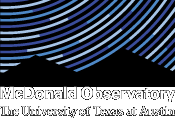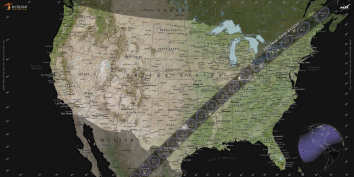April 8 Total Solar Eclipse
On April 8, 2024, a total solar eclipse will travel across North America, with the Moon surrounded by the Sun’s delicate corona. Texas will be a great spot to experience it – the state is in the "path of totality" and typically enjoys clear, cloud-free weather.
McDonald Observatory is not in the path of totality. However, we will be able to see a partial solar eclipse.
Jump to a section of this page:
Experience the Eclipse with Us
Training Sessions: How to Host a Viewing Event
What Is a Solar Eclipse?
When the Moon orbits Earth, it sometimes moves between the Sun and Earth. When it does, the Moon casts a shadow on Earth that either fully or partially blocks the Sun’s light in some areas. This is a solar eclipse.
We are able to experience solar eclipses because of an incredible astronomical coincidence: the apparent sizes of our Sun and Moon are both the same when seen from Earth. This is because, although the Sun is roughly 400 times larger in diameter than the Moon, the Moon is also 400 times closer to us than the Sun.
There are four types of solar eclipses:
- Total solar eclipse: The Moon passes between the Earth and Sun, completely covering the Sun’s disk along a narrow path. You must be within that narrow path to experience a total solar eclipse.
- Annular solar eclipse: The Moon’s distance from Earth varies by roughly 31,000 miles (50,000 km). If an eclipse occurs when the Moon is farther away than average, the Moon isn’t quite wide enough to completely cover the Sun. That leaves a “ring of fire” around the Moon.
- Hybrid solar eclipse: On rare occasions, the beginning and end of a solar eclipse can be annular, with a total eclipse sandwiched in between.
- Partial solar eclipse: When the Moon blocks only a part of the Sun it creates a partial eclipse. All solar eclipses include partial phases, while some eclipses offer only partial coverage, with the Moon-Sun alignment not quite precise enough for a total or annular period.
Solar Eclipse Safely
If you are inside the path of totality, it is safe to look at the eclipse with your naked eye during the brief moment when the Moon entirely covers the Sun (totality). At all other times, it is unsafe to look at the eclipse without adequate eye protection. Be sure to put your eclipse viewers/glasses back on before totality ends!
If you are outside the path of totality, there is never a time when it is safe to look at the eclipse without adequate eye protection
Adequate protection includes:
- Eclipse glasses and viewers: Make sure they meet an international standard of eye protection (ISO 12312-2), are certified, and are free of scratches or other flaws.
- Welder’s glass: No. 13 or 14 welder’s glass provide both protection and visibility.
Visit the American Astronomical Society’s website to learn about eclipse eye safety.
Where and When to View It
This interactive map lets you look up when the solar eclipse will be visible (if at all) from any given location:
Another resource for looking up the eclipse path is the Totality app (free).
Approximate eclipse times for Texas cities (there will be minor variations in times based on the observer’s location in each city)
| City | Eclipse Begins | Totality Begins | Totality Ends | Eclipse Ends | Duration of Totality |
|---|---|---|---|---|---|
| Eagle Pass | 12:10 p.m. | 1:27 p.m. | 1:31 p.m. | 2:51 p.m. | 4 min 24 sec |
| Fredericksburg | 12:15 p.m. | 1:32 p.m. | 1:37 p.m. | 2:56 p.m. | 4 min 24 sec |
| Austin (western) | 12:17 p.m. | 1:36 p.m. | 1:38 p.m. | 2:58 p.m. | 1 min 44 sec |
| Waco | 12:20 p.m. | 1:37 p.m. | 13:42 p.m. | 3:00 p.m. | 4 min 12 sec |
| Dallas | 12:23 p.m. | 1:40 p.m. | 1:44 p.m. | 3:02 p.m. | 3 min 51 sec |
When choosing a viewing location, consider:
- Weather: Check if the location historically has clear, cloud-free skies on the date of the eclipse. The night before, check the forecast and have an alternate viewing site in mind if yours will be clouded out.
- Lodging: Hotels along the path of totality will fill up quickly. Book yours well in advance.
- Traffic: Traffic will be heavy, so plan your route in advance and allow plenty of time to reach your viewing site.
What to Look For
Those who have seen a total eclipse say nothing else compares. If you are lucky enough to be within the path of totality, here are some of the things you may experience:
Just Before (and After) Totality
The temperature of the air will drop and the light will dim.
- Creatures may act as though it’s dusk. This can include birds going to roost and crickets chirping.
- Streetlights may come on.
- Sunlight shining through pinholes, such as tree leaves, will project crescent shapes onto the ground.
- Rapidly moving, long, dark shadows, called “shadow bands,” will be visible on the ground and sides of buildings. This is caused by the Earth’s atmosphere distorting the sunlight in the same way it causes starlight to twinkle.
- The last specks of light, called Baily’s Beads, will be visible around the edge of the Sun. They correspond to where valleys are present on the Moon’s surface. This phenomenon is short-lived and may not last long enough to notice.
During Totality
The Moon must cover the Sun completely for you to experience the effects of totality. If the Moon covers 99.9% of the Sun, that is still only a partial eclipse.
When the Moon blocks 100% of the Sun:
- The Sun’s corona (its outer atmosphere) will be visible. It will look like delicate, feathery tendrils radiating outwards.
- You may see bright pink spots at the Sun’s edges. These are gigantic loops of plasma rising from the Sun’s surface, called “prominences.” Their color is thanks to glowing hydrogen gas.
- Bright stars and planets may be visible in the sky.
- The light will be dim and you may be surrounded by a 360-degree sunset.
Experience the Eclipse with Us
McDonald Observatory and UT Austin representatives will be onsite for eclipse events in:
- Austin, The University of Texas at Austin (1 min 48 sec of totality): UT is planning a viewing experience for the University community. Stations located across campus will distribute viewing glasses and share eclipse information. More details coming soon to eclipse.utexas.edu.
- Austin, Lady Bird Johnson Wildflower Center (2 min of totality): The Wildflower Center will have educational demonstrations that explore plants’ interactions with the Sun and eclipses.
- Austin, Long Center for the Performing Arts (1 min 44 sec of totality): The Long Center and Simons Foundation, as part of its In the Path of Totality initiative, are hosting a free eclipse viewing party on the Long Center lawn and H-E-B Terrace. Participants can check out a replica of the McDonald Observatory's Hobby-Eberly Telescope. RSVP required.
- Fort Davis, McDonald Observatory (no totality): Although we will only see a partial eclipse, we are preparing for visitors who want to experience it at McDonald Observatory. We will have telescopes set up for solar viewing, educational activities, and demos.
Be sure to check in advance with these and any other event locations for information on entry requirements, parking/transportation, and more. Eclipse viewings are likely to draw a crowd!
Training Sessions: How to Host a Viewing Event
McDonald Observatory is providing online training (via Zoom) for K-12 educators, community volunteers, and others who are planning to host their own viewing events. Workshops cover the science of eclipses, how to experience them safely, and tips for hosting an event.
After the workshop, McDonald Observatory will send educational materials to attendees. Some event locations will be selected to receive physical materials including eclipse viewers and StarDate Eclipse Guides.
Upcoming sessions:
- We are not holding any additional sessions. However, you can watch a recording on our YouTube channel
Additional Resources
StarDate Radio (produced by McDonald Observatory) will also create a special feature audio program about the eclipse that will be distributed to event partners throughout the state along with Public Service Announcements to help promote and educate a large audience about this special event.
Training sessions and resources are available thanks to generous support from the Abell-Hanger Foundation and Friends of McDonald Observatory.
Connect with an Expert
- Eclipse Event Planners: Due to the large number of requests, we are no longer able to provide speakers for eclipse events. To become your own eclipse expert, we encourage event hosts to attend one of our training sessions. You are also invited to play our eclipse explainer video at your event - please fill out this form for access.
- Media and Press: To request an interview with an astronomer for an upcoming news story, contact emily.howard@austin.utexas.edu.
- Teachers and Educators: To discuss eclipse training sessions, contact teachers@mcdonaldobservatory.org.
- Visit the Contact page of our website for additional ways to connect with us.


